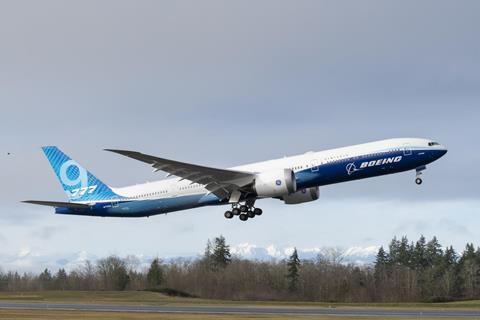US FAA administrator Steve Dickson expects changes being considered in the wake of the Boeing 737 Max crisis could impact future “grandfathered” certification of derivative aircraft such as the 777X, which recently began flight-testing.
Major aircraft derivatives like the new 777X family – which features key changes such as a new carbonfibre wing with folding tips, new-generation engines, systems and flightdeck and larger cabin windows – can use “grandfather rights” to be certificated as amendments to an existing type certificate, even if the original approval dates back decades.
The 737 Max was approved as a derivative of the FAA’s original 1967 certification of the 737-100. The 777-9, which is the first variant of the 777X family, made its first flight on 25 January. Boeing aims to certificate the 777X as derivative of the original 777-200, which was approved in April 1995.
The FAA’s “changed product rule” requires applicants to apply for a new type certificate for a “changed product” if it decides that “the change in design, power, thrust, or weight is so extensive that a substantially complete investigation of compliance with the applicable regulations is required”.

Speaking at the Aviation Club of the UK today, Dickson explained that the FAA is re-examining the changed product rule as well as taking input from the findings of the technical advisory board (TAB) set up in the wake of the Max grounding. The TAB is an independent panel which the FAA has asked to review its work regarding the 737 Max return-to-service effort.
“In terms of 777X and what certification [of derivative aircraft] will look like going forward beyond that – those are related but different subjects,” said Dickson.
“We will take some of the processes that we’re using now with the 737 Max, such as the technical advisory board, with the 777X [certification].”
Dickson says that the changed product rule is also to be scrutinised.
“Moving forward, one of the recommendations is to go back and work with all the authorities on the changed product rule, which has been harmonised globally,” he says. “That’s something that we will certainly undertake with the other states of design around the world to make that determination of what that process looks like.”
Dickson adds that there are too many variables currently to be specific on how it might affect individual aircraft such as the 777X.
“I don’t think it’s something you can put a number on. It depends on the architecture of the aircraft: for example, if it’s more software-based and less hardware-based then that may create some changes in how that is approached in the future.”


























